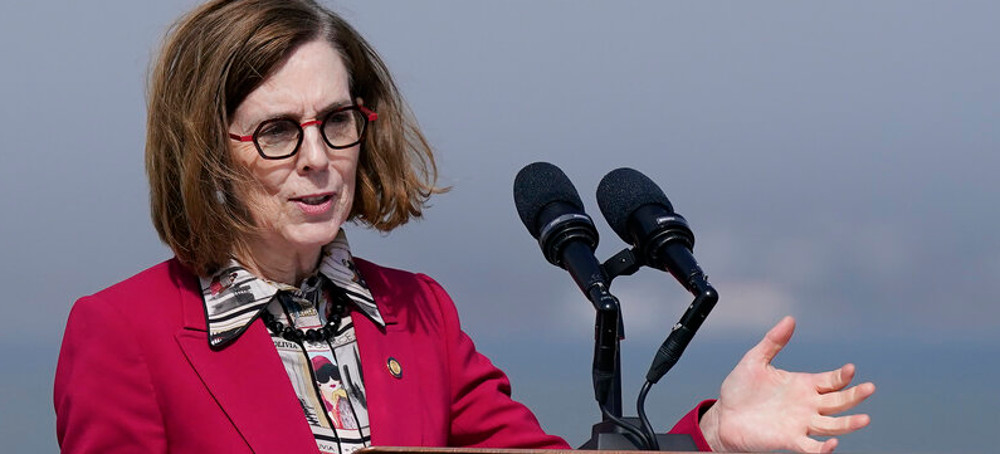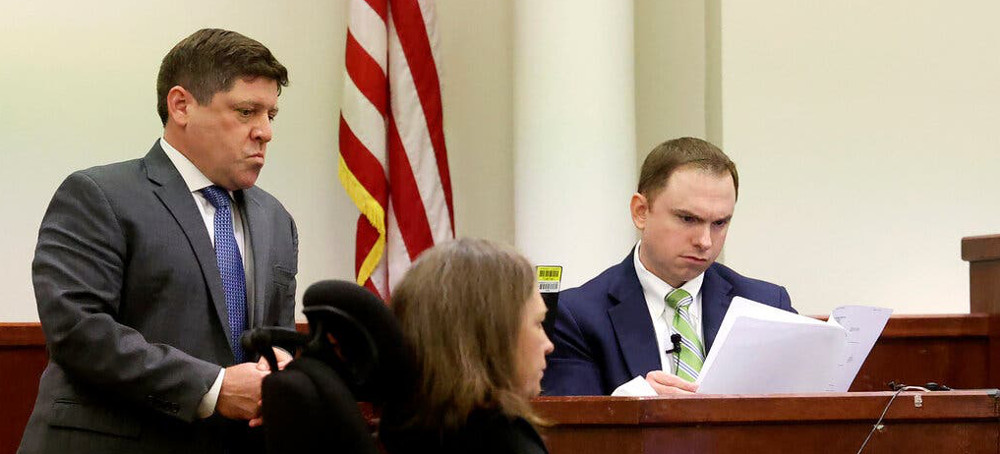Live on the homepage now!
Reader Supported News
ALSO SEE: JFK Assassination Records - 2022 Additional Documents Release
The newly released tranche of files — 13,173 documents — was posted by the National Archives and Records Administration after President Biden issued a memorandum.
“[The] profound national tragedy of President Kennedy’s assassination continues to resonate in American history and in the memories of so many Americans who were alive on that terrible day; meanwhile, the need to protect records concerning the assassination has weakened with the passage of time,” Biden wrote in the memorandum. “It is therefore critical to ensure that the United States Government maximizes transparency by disclosing all information in records concerning the assassination, except when the strongest possible reasons counsel otherwise.”
Kennedy’s assassination — and the subsequent withholding of government documents related to his death — spawned conspiracy theories over nearly six decades, particularly surrounding gunman Lee Harvey Oswald. The Warren Commission concluded that Oswald acted alone when he killed the president on Nov. 22, 1963, and that there was no conspiracy.
A large number of the documents released Thursday belonged to the CIA. Several focused on Oswald’s movements, his contacts and even whether it was really his signature on a visa application for Cuba. Other documents focus on requests from the Warren Commission.
One document, dated June 22, 1962, notes that Oswald was mentioned in a recent Washington Post article as having defected to the Soviet Union — indicating that Oswald was on the CIA’s radar more than a year before Kennedy was assassinated.
“A former Marine Sgt. of Fort Worth, Texas, who defected to the U.S.S.R. three years ago, left Moscow recently together with his infant child and Russian-born wife bound for the United States,” the document said.
A December 1963 document described how CIA officials in Mexico City “intercepted a telephone call” Oswald made in October from that city to the Soviet Embassy there “using his own name” and speaking “broken Russian.”
Oswald, according to the document, had visited the embassy earlier and claimed someone there promised “to send a tele-gram for him to Washington.” In the call, Oswald asked if there was “anything new.”
The 23-page document goes on to say, “Our Mexico City Station very often produces information like this on US citizens contacting Soviet bloc embassies in Mexico City. Frequently the information we get is extremely incriminating.”
Another document, from September 1964 and marked secret, described American officials discussing Oswald and his killing. The official, Felix Dmitreyevich Karasev, said he believed it was impossible for the gunman, Jack Ruby, to have killed Oswald “without the assistance of some U.S. officials,” according to the document.
The official, in Helsinki, went on to write, “We tried to debunk this impression, but Karasev held to his views.”
With Thursday’s release, 95 percent of the documents in the CIA’s JFK assassination records collection will have been released in their entirety, a CIA spokesperson said in a statement, and no documents will remain redacted or withheld in full after “an intensive one-year review” of all previously unreleased information.
“We have made tremendous progress in our review of CIA’s collection of records. We’re talking about over 87,000 documents originally included in the JFK Act collection,” the spokesperson said, speaking on the condition of anonymity ahead of the release of the documents.
The CIA spokesperson justified the continued redaction of some documents, saying they contain information that details CIA intelligence sources and methods — some from as late as the late 1990s, given to help provide context about the CIA’s methods and terminology.
“CIA believes all of its information known to be directly related to the assassination of President John F. Kennedy in 1963 has already been released,” the spokesperson said.
In an initial review, the documents that were released did not appear to contain explosive new evidence of the decades-old assassination and sweeping fallout that followed.
Rather, many of the documents appeared to summarize stories referencing the murder that stunned the world, or showed how officials responded to news inquiries (“advising that his scoop may, in fact, be old news.”) At least one document recalled how a low-level government clerk erroneously believed that documents about Oswald had been tampered with.
Under the 1992 President John F. Kennedy Assassination Records Collection Act, all assassination records should have been publicly disclosed within 25 years — or by October 2017 — but postponements were allowed in instances that national security concerns outweighed the public interest in disclosure.
President Donald Trump in 2017 announced that he planned to publicly disclose the remaining JFK files, only to delay the release of some of the files for national security reasons, setting a new deadline of Oct. 26, 2021. In 2018, Trump did end up authorizing the disclosure of 19,045 documents, about three-quarters of which still contained some redactions.
All of the remaining JFK files were originally supposed to have been released last October. Biden postponed that planned release, citing delays caused by the coronavirus pandemic, and announced that they would be instead disclosed in two batches — one on Dec. 15, 2021, and another by Dec. 15, 2022, after undergoing an “intensive 1-year review.”
“Temporary continued postponement is necessary to protect against identifiable harm to the military defense, intelligence operations, law enforcement, or the conduct of foreign relations that is of such gravity that it outweighs the public interest in immediate disclosure,” Biden said last October.
The decision upset JFK researchers, who accused the Biden administration of using the pandemic as an excuse for the government to stonewall the public yet again, noting it had been almost 60 years since Kennedy was assassinated.
“It’s bizarre. It’s been almost 60 years since my uncle’s death,” Robert Kennedy Jr. told NBC News in October. “What are they hiding?”
The CIA spokesperson pushed back Thursday against assertions that the agency is withholding information related to Oswald.
“CIA believes all substantive information known to be directly related to Oswald has been released. The few remaining redactions protect CIA employee names, sources, locations, and CIA tradecraft,” the spokesperson said. “Likewise, we are not aware of any documents known to be directly related to Oswald that have not already been made part of the Collection.”
Jefferson Morley, a former Washington Post staff writer and the vice president of the Mary Ferrell Foundation — which sued the Biden administration in October over the delay of the release — said his group was particularly interested in looking at a batch of “30 to 40 significant documents with redactions” that had been released previously, and comparing them to what would be released Thursday afternoon.
Morley said he was not encouraged by Thursday’s release and felt the CIA was not acting in “good faith” to release all available information. Morley cited a 15-page document from 1961 — two years before the assassination — from Arthur Schlesinger Jr. to Kennedy titled “Memo to President CIA Reorganization.” As of Thursday, it remained partially redacted. “What the CIA has hidden,” Morley said, is whether the CIA had “operational interest in Oswald” at the time of the assassination.
In a memorandum Thursday, Biden said that until May 1, 2023, the National Archives and relevant agencies “shall jointly review the remaining redactions in the records.” After that review process, “any information withheld from public disclosure that agencies do not propose for continued postponement” will be released by June 30, 2023.
READ MORE  Oregon Gov. Kate Brown, pictured in San Francisco in October, commuted the sentences of all 17 people on death row on her way out of office. (photo: Jeff Chiu/AP)
Oregon Gov. Kate Brown, pictured in San Francisco in October, commuted the sentences of all 17 people on death row on her way out of office. (photo: Jeff Chiu/AP)
Now, with just weeks left in office, she is commuting the sentences of all 17 people on death row in the state. They will instead serve life in prison with no chance of parole.
The Democrat announced on Tuesday that she would use her executive clemency powers to make the commutations, which took effect the following day. And she emphasized that, unlike previous commutations she's granted, they are not based on any "rehabilitative efforts" by the individuals on death row.
"Instead, it reflects the recognition that the death penalty is immoral," she said in a statement. "It is an irreversible punishment that does not allow for correction; is wasteful of taxpayer dollars; does not make communities safer; and cannot be and never has been administered fairly and equitably."
She also acknowledged the pain and uncertainty for victims as individuals sit on death row for decades without resolution, adding that she hopes this move "will bring us a significant step closer to finality in these cases."
Why Oregon?
Oregon has executed two individuals in the last half century, most recently in 1997. The state has abolished and readopted capital punishment several times throughout it history. Voters last brought the death penalty back in 1984, three years after the Oregon Supreme Court declared it unconstitutional.
Then-Gov. John Kitzhaber imposed a moratorium in 2011, which Brown has continued, and a 2019 bill significantly narrowed the scope of what constitutes a capital offense in the state.
The following year, Oregon's Department of Corrections closed its death-row facility and moved those individuals into the general prison population. And the state Supreme Court struck down one inmate's death sentence in a major 2021 ruling that attorneys said could eradicate the sentence of dozens of others in the state.
Brown has used her power of clemency more than any of the state's previous governors, Oregon Public Broadcasting reports. She granted clemency to nearly 1,000 people during the COVID-19 pandemic, a move that sparked legal challenges but was ultimately upheld by an Oregon appeals court.
Brown tells Morning Edition's Rachel Martin that the majority of her clemency work has been geared towards moving Oregon towards a more equitable criminal justice system — and notes that a disproportionate number of those currently on death row in the state are people of color. She says this particular action is different because it's based solely on "the immorality of the death penalty."
"Justice is not advanced by taking a life and the state should not be in the business of executing people, even if a horrible, horrible crime or crimes placed them in prison," Brown says. "The death penalty also has never been administered fairly, consistently, or equitably in Oregon or frankly, across the United States."
Why now?
Brown stresses that she's made her personal opposition to the death penalty clear from the outset, and outlined the progress her state has made in that direction during her tenure. She has also ordered the state to shut down and empty its execution chamber, and told OPB that the rarely-used room will be repurposed.
It's not unusual for governors to wait until their final terms to exercise their clemency power, she tells Morning Edition (Oregon limits its governors to two four-year terms). According to the American Civil Liberties Union, several former and current governors from both parties have used those powers to commute their state's death rows, including Gov. Jared Polis (D-Colo.), Gov. George Ryan (R-Ill.), and Gov. Jon Corzine (D-N.J.).
"It's certainly unacceptable to me that I would leave office without taking one final action to ensure that none of these individuals will be executed by the state," Brown says.
While Brown's decision has drawn praise from plenty of criminal justice advocates, it's also sparked backlash from some state Republicans (who make up a minority of the legislature) and family members of victims.
She says she's confident that her commutations would be upheld in court if challenged, citing the recent court of appeals ruling restating the governor's broad authority in this area. And she rejects the idea that she acted without a mandate from her constituents.
"I was elected by a majority of Oregonians, and I know that they share my values, that the death penalty is both dysfunctional and immoral. It is applied inequitably. And absolutely it does not make sense," Brown says. "And I will say that Oregonians have elected time and time again governors that oppose the death penalty."
What's next?
Gov.-elect Tina Kotek, also a Democrat, told OPB while campaigning that she is opposed to the death penalty because of her religious beliefs, and would continue the moratorium if elected.
Her spokesperson told Portland TV station KATU this week that Brown's decision "is generally aligned with her values."
Brown is the third Oregon governor to commute death sentences, according to the Death Penalty Information Center. Gov. Robert Holmes commuted those imposed during his term in office from 1957-1959, and Gov. Mark Hatfield commuted all death row sentences in 1964.
READ MORE The Israeli and United States flags are projected on the walls of Jerusalem's Old City, to mark one year since the transfer of the U.S. Embassy from Tel Aviv to Jerusalem, on May 15, 2019. (photo: Ahmad Gharabli/Getty)
The Israeli and United States flags are projected on the walls of Jerusalem's Old City, to mark one year since the transfer of the U.S. Embassy from Tel Aviv to Jerusalem, on May 15, 2019. (photo: Ahmad Gharabli/Getty)
Biden Moves Ahead on Trump Plan to Build Israel Embassy on Stolen Palestinian Land
Alice Speri, The Intercept
Speri writes: "Objections from the land's rightful owners - including U.S. citizens - are going unacknowledged by the administration."
READ MORE  Dale Smith, assistant Tarrant County criminal district attorney, left, cross-examined Aaron Dean on Monday. (photo: Amanda Mccoy/AP)
Dale Smith, assistant Tarrant County criminal district attorney, left, cross-examined Aaron Dean on Monday. (photo: Amanda Mccoy/AP)
A former Fort Worth police officer, Aaron Dean, was convicted of manslaughter in the shooting of Atatiana Jefferson. She was shot through her bedroom window.
The jury in Fort Worth did not convict the officer, Aaron Dean, on the murder charge that prosecutors had sought. He could face up to 20 years in prison after the two-week trial that took place after years in delays.
The October 2019 shooting occurred when Atatiana Jefferson, who had been playing video games with her 8-year-old nephew, heard a noise and grabbed her gun as she went to look out her bedroom window. Mr. Dean, who had been called by a neighbor who had reported open doors at the house late at night, yelled at Ms. Jefferson to put her arms up and immediately fired a single shot through her window.
 Twitter's latest suspensions could prove particularly costly. (photo: Jim Watson/Getty)
Twitter's latest suspensions could prove particularly costly. (photo: Jim Watson/Getty)
Musk joined a Twitter Space to say the suspensions were related to new rules banning private jet trackers. Twitter suspended an account that tweeted the whereabouts of his plane.
Hours after the suspensions took hold, Musk faced off with one of the journalists he suspended in a Twitter Space audio discussion before an audience of more than 30,000 listeners. The suspended journalist, along with several others, found a backdoor way onto the platform through the website's audio function.
“You doxx, you get suspended. End of story. That's it,” Musk said, explaining his latest policy to the group, before he left minutes after having joined the discussion.
Musk was referring to Twitter's latest rule change about accounts that track private jets, including one owned by Musk himself, which was put in place Wednesday.
The audio discussion and the Twitter’s Spaces feature was abruptly shut down after Musk exited the conversation. Musk tweeted, "we're fixing a Legacy bug. Should be working tomorrow."
The discussion revolved around the suspension of numerous journalists. The accounts of Ryan Mac of The New York Times, Donie O'Sullivan of CNN, Drew Harwell of The Washington Post, Matt Binder of Mashable, Micah Lee of The Intercept, Steve Herman of Voice of America and independent journalists Aaron Rupar, Keith Olbermann and Tony Webster had all been suspended as of Thursday evening.
The Twitter account for Mastodon, a platform billed as a Twitter alternative, was also suspended early Thursday evening. Twitter accounts operated by NBC News journalists were unable to tweet any links to Mastodon pages. Mastodon was, however, trending on Twitter.
Musk said the suspensions stemmed from the platform's new rules banning private jet trackers, responding to a tweet from Mike Solana, a vice president of the venture capital firm Founders Fund, who noted that the suspended accounts had posted links to jet trackers on other websites.
"Criticizing me all day long is totally fine, but doxxing my real-time location and endangering my family is not," he said in another tweet.
Musk tweeted that the accounts banned Thursday posted "my exact real-time location, basically assassination coordinates, in (obvious) direct violation of Twitter terms of service." NBC News was unable to verify that allegation.
Musk later added that the suspensions would last seven days.
In early November, shortly after having taken control of Twitter, Musk tweeted that he would not ban the account that tracked his jet.
Rupar wrote on Substack that his account was permanently suspended but that he had no other information.
"I haven’t heard anything from Twitter at all," he wrote.
He noted that he had tweeted a link Wednesday to a Facebook page that tracked Musk’s jet.
Binder, a tech reporter at Mashable, said he was suspended after he tweeted a screenshot from another suspended reporter, CNN’s O’Sullivan, of a Los Angeles Police Department statement.
"I’ve been on it since 2008. I never got so much as a slap on the wrist, because I always follow the rules," Binder said. "It’s not hard to do when you know what the rules are."
Binder said his account notified him that he is permanently suspended.
"This is the very stuff that he’s criticized the previous Twitter of doing," Binder said of Musk.
Binder did appear to find a loophole in Twitter's suspension, joining an audio discussion on Twitter's Spaces feature with other journalists Thursday night. Harwell later also joined.
"I'm breaking the law in ways that have never been broken before," Binder joked.
Jack Sweeney, a 20-year-old Florida college student who created the Twitter account that tracked Musk's jet, was also able to join the discussion despite his account's suspension.
Musk later joined the discussion, but briefly — getting out his talking points and then leaving abruptly. He had earlier put up a poll with a variety of options, asking whether or when he should reinstate the journalists’ accounts. When a plurality of respondents voted to restore the accounts immediately, he deleted the poll and started a new one with fewer options.
O’Sullivan said Thursday that all those journalists who were suspended with him were people who cover Musk.
“As we saw with the jet tracker last night, Musk seems to be just stamping out accounts that he doesn’t like,” O’Sullivan said on CNN.
A spokesperson for the network said the suspensions were “impulsive and unjustified” — but not surprising.
“Twitter’s increasing instability and volatility should be of incredible concern for everyone who uses Twitter,” the network said in a statement. “We have asked Twitter for an explanation, and we will reevaluate our relationship based on that response.”
Sally Buzbee, the executive editor of The Washington Post, said Harwell’s suspension “directly undermines Elon Musk’s claim that he intends to run Twitter as a platform dedicated to free speech.”
Harwell was “banished from Twitter without warning, process or explanation, following the publication of his accurate reporting about Musk” and should be reinstated immediately, Buzbee said in a statement Thursday night.
A spokesperson for The New York Times, who called the suspensions questionable and unfortunate, said no explanation was provided to Mac or the newspaper about the ban.
Rep. Lori Trahan, D-Mass., tweeted that she had met on Thursday with Twitter representatives, who said the company would not take action against journalists who criticize the platform.
"Less than 12 hours later, multiple technology reporters have been suspended. What’s the deal, @elonmusk?" Trahan added.
Musk has backtracked on his promise that he would run Twitter as a free speech absolutist, reinstating accounts associated with the QAnon movement and other far-right groups while banning others.
Internally, he has removed critics of his policies from the company.
The suspensions add to what has been a tumultuous couple of days for Twitter after it first suspended the account that tracked Musk’s jet.
Musk appeared to threaten legal action against Sweeney, the creator of the @ElonJet account, after he claimed that a “stalker” confronted a car carrying his child in Los Angeles on Tuesday.
Musk provided no proof that Sweeney or his account was involved. He did not provide a time or location in the sprawling metropolitan area where he claimed the incident occurred.
Sweeney told NBC News on Wednesday that he hasn’t received any notification of legal action and that the last time his bot tweeted anything was Monday, “which is not last night, so I don’t get how that’s connected.”
The Los Angeles Police Department said Thursday that no police reports had been filed.
“LAPD’s Threat Management Unit is aware of the situation and tweet by Elon Musk and is in contact with his representatives and security team. No crime reports have been filed yet,” Officer Lizeth Lomeli, a police public information officer, said in a statement Thursday evening.
Other law enforcement departments also cover parts of the Los Angeles metropolitan area.
READ MORE  Rep. Ilhan Omar, D-MN, pictured in January 2018. (photo: Marcio Jose Sanchez/AP)
Rep. Ilhan Omar, D-MN, pictured in January 2018. (photo: Marcio Jose Sanchez/AP)
US Congresswoman says Hale's case 'is exactly what the pardon power is for'
"Daniel does not threaten anyone. He has taken responsibility for his actions, he did his country a service. And it is time we acknowledge that and repay him," Omar said during an online press conference on Thursday morning.
"Daniel's case is exactly what the pardon power is for," Omar said. "I take the prohibition of revealing classified information extremely seriously. But what Daniel did was courageous. What Daniel did was patriotic. What he did was public service."
The conference was hosted by the Daniel Hale Support Network, a coalition of organisations and friends of Hale working to advocate for his release.
Omar made a similar call in August 2021, sending a letter to the White House saying that Hale "has shone a vital light on the legal and moral problems of the drone program and informed the public debate on an issue that has for too many years remained in the shadows".
Last year, Hale was sentenced to 45 months in prison, after pleading guilty to one charge out of five related to the dissemination of the documents, which exposed secrets about US drone warfare, including how often civilians were killed during strikes in Yemen, Pakistan, Afghanistan, and Somalia. He was sentenced under the Espionage Act of 1917.
Hale served in the US military during the first term of the Obama administration, a period that saw a rise in the number of drone strikes conducted by American forces.
A total of 563 air strikes, mostly by drones, targeted Pakistan, Somalia and Yemen during Barack Obama's eight years in office, compared with 57 under his predecessor George W Bush, according to the Bureau of Investigative Journalism.
The Council of Foreign Relations (CFR) estimates that 3,797 people were killed in drone strikes during Obama's tenure, including 324 civilians, a number that is disputed.
The former Air Force intelligence analyst was one of at least eight alleged media sources to be criminally prosecuted - and the fifth to be charged under the Espionage Act - during the Trump administration. Hale was the first such case to be sentenced under the Biden administration.
In his sentencing hearing, Hale said: "I am here because I stole something that was never mine to take - precious human life. I couldn’t keep living in a world in which people pretend that things weren’t happening that were. Please, your honor, forgive me for taking papers instead of human lives."
During the press conference, Omar was joined by Hale's family, experts on the US military, and other whistleblowers including Daniel Ellsberg, a former military analyst who in 1971 released a top-secret study of the US's decision-making in the Vietnam War that came to be known as the Pentagon Papers.
"Daniel Hale is unmistakably one of my heroes. It just so happens that he faced trial for the same acts that I took 50 years ago in releasing the Pentagon Papers," Ellsberg said.
"And for much the same reason - an unconstitutional war going on not declared by Congress, committing endless crimes of war."
Omar and other US lawmakers have shown support for reforming the Espionage Act, which was passed more than 100 years ago during the First World War, and has for decades been used against whistleblowers.
Congresswoman Rashida Tlaib tried to include an amendment to the 2023 Pentagon spending bill, known as the National Defense Authorization Act (NDAA), that would allow whistleblowers to defend themselves by arguing that their disclosures to the media were in the public interest.
But it is unclear whether the amendment will make it into the final version of the NDAA. Meanwhile, the Biden administration is fighting to extradite Julian Assange, the founder of WikiLeaks, so that he can also be tried under the Espionage Act.
READ MORE  California air regulators voted unanimously Thursday to approve an ambitious plan to drastically cut reliance on fossil fuels. (photo: iStock)
California air regulators voted unanimously Thursday to approve an ambitious plan to drastically cut reliance on fossil fuels. (photo: iStock)
The plan sets out to achieve so-called carbon neutrality by 2045, meaning the state will remove as many carbon emissions from the atmosphere as it emits. It aims to do so in part by reducing fossil fuel demand by 86% within that time frame.
California had previously set this carbon neutrality target, but Gov. Gavin Newsom signed legislation making it a mandate earlier this year. The Democrat has said drastic changes are needed to position California as a global climate leader.
“We are making history here in California,” Newsom said in a statement Thursday.
But the plan’s road to approval by the California Air Resources Board was not without criticism. Capturing large amounts of carbon and storing it underground is one of the most controversial elements of the proposal. Critics say it gives the state’s biggest emitters reason to not do enough on their part to mitigate climate change.
In a meeting that lasted several hours, activists, residents and experts used their last chance to weigh in on the plan ahead of the board’s vote. Many said the latest version, while not perfect, was an improvement from earlier drafts, committing the state to do more to curb planet-warming emissions.
Davina Hurt, a board member, said she was proud California is moving closer to its carbon neutrality goal.
“I’m glad that this plan is bold and aggressive,” Hurt said.
The plan does not commit the state to taking any particular actions but sets out a broad roadmap for how California can achieve its goals. Here are the highlights:
RENEWABLE POWER
The implementation of the plan hinges on the state’s ability to transition away from fossil fuels and rely more on renewable resources for energy. It calls for the state to cut liquid petroleum fuel demand by 94% by 2045, and quadruple solar and wind capacity along that same timeframe.
Another goal would mean new residential and commercial buildings will be powered by electric appliances before the next decade.
The calls for dramatically lowering reliance on oil and gas come as public officials continue to grapple with how to avoid blackouts when record-breaking heat waves push Californians to crank up their air conditioning.
And the Western States Petroleum Association took issue with the plan’s timeline.
“CARB’s latest draft of the Scoping Plan has acknowledged what dozens of studies have confirmed — that a complete phase-out of oil and gas is unrealistic,” said Catherine Reheis-Boyd, the group’s president, in a statement. “A plan that isn’t realistic isn’t really a plan at all.”
At the beginning of Thursday’s meeting, California Air Resources Board Chair Liane Randolph touted the latest version of the plan as the most ambitious to date. It underwent changes after public comments earlier this year.
“Ultimately, achieving carbon neutrality requires deploying all tools available to us to reduce emissions and store carbon,” Randolph said.
TRANSPORTATION
Officials hope a move away from gas-powered cars and trucks reduces greenhouse gas emissions while limiting the public health impact of chemicals these vehicles release.
In a July letter to the air board, Newsom requested that the agency approve aggressive cuts to emissions from planes. This would accompany other reductions in the transportation sector as the state transitions to all zero-emission vehicle sales by 2035.
The plan’s targets include having 20% of aviation fuel demand come from electric or hydrogen sources by 2045 and ensuring all medium-duty vehicles sold are zero-emission by 2040. The board has already passed a policy to ban the sale of new cars powered solely by gasoline in the state starting in 2035.
CARBON CAPTURE
The plan refers to carbon capture as a “necessary tool” to implement in the state alongside other strategies to mitigate climate change. It calls for the state to capture 100 million metric tons of carbon dioxide equivalent and store it underground by 2045.
Connie Cho, an attorney for environmental justice group Communities for a Better Environment, called the plan “a huge step forward” to mitigate climate change and protect public health.
“Our communities have been suffering from chronic disease and dying at disproportionate rates for far too long because of the legacy of environmental racism in this country,” Cho said.
But Cho criticized its carbon capture targets, arguing they give a pathway for refineries to continue polluting as the state cuts emissions in other areas.
AGRICULTURE
One of the goals is to achieve a 66% reduction in methane emissions from the agriculture sector by 2045. Cattle are a significant source for releasing methane — a potent, planet-warming gas.
The plan’s implementation would also mean less reliance by the agriculture sector on fossil fuels as an energy source.
Follow us on facebook and twitter!
PO Box 2043 / Citrus Heights, CA 95611



No comments:
Post a Comment
Note: Only a member of this blog may post a comment.